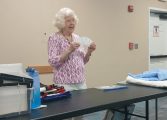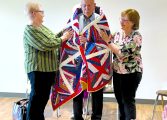By Page H. Gifford
Correspondent
At their monthly meeting on March 21, the members of the Fluvanna Art Association gathered for a different talk and demonstration. Usually, there is one artist and one demonstration, talk, or workshop on any given subject relating to art. But this time four members decided to try something new. Four artists led four rotating groups, during 15-minute increments to learn a new technique. Among the techniques being demonstrated or discussed, were mindful doodling to enhance concentration and de-stress; intuitive painting, and two different printing techniques.
Mindful doodling is a form of reckless abandonment, letting the mind wander yet focusing on patterns and detail which calms the mind and strengthens focus.
Intuitive painting is another way for artists to be in tune with their creative side.
“Intuitive painting is concentrating on the inside rather than on an outside reference point,” said artist Jane Prete. “It gives us freedom and it’s all original.” Prete is a proponent of allowing an idea or thought to flourish within the artist, eventually translating it onto canvas or paper.
“Inspiration takes many forms and paint tells us where we are going.” Prete’s work reflects her philosophy with its light ethereal abstract impressionism in watercolor. The soft suggestion of her subjects speaks about her originality.
Gelli plate printing takes practice but is a fun way for artists to build on the first two demonstrations by utilizing this technique in their work as Amy Jeanguenat does with her collages. All the tools needed are a gel plate, acrylic paint, and a brayer. Gelli plates come in different sizes. It takes experimentation to see what makes a good print, but Jeanguenat suggests images from a laser printer and experimenting with certain magazines.
“Vogue is one of the best,” she said. She rolls on the plate a thin layer of paint then puts the photo, drawing, etc. facedown on the plate and gently rubs it with her fingers then lifts it to reveal a ghostly facsimile of the original image.
She adds you can use other items for printing including leaves, stencils, and other flat objects. It’s a fun and easy way to print and add to a variety of original artworks.
The last of the four artists, Diane Wilkin, was also showing a more involved process for making beautiful prints on Reemay paper (air filter paper), using clay. She began with dry porcelain clay, added water, and blended to a certain consistency.
“You can add color by adding pigments, not paint,” she said. She then worked on a one-half-inch thick slab of what she called leather hard clay, not fired. “You can create the image using a variety of methods, including stencils.”
She laid the Reemay paper onto the image surface. She rubbed the back, checked the image, and sprayed with water to help the image form. When transferred, she pulled the image off the slab and let it dry. She suggests spraying with a fixative or light varnish to preserve it.
“You can embellish it, if you desire, with acrylic or pastel.” She adds that this process only provides for one print and that once the clay particles are transferred, only a weak ghost image remains.




